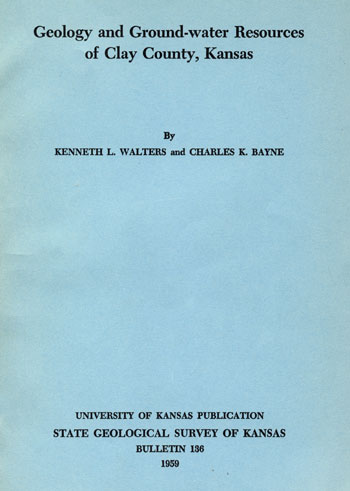Geology and Ground-water Resources of Clay County, Kansas
By Kenneth L. Walters and Charles K. Bayne

Originally published in 1959 as Kansas Geological Survey Bulletin 136. This is, in general, the original text as published. The information has not been updated.
You may also wish to visit our web site on the Clay County geologic map.
Abstract
This report describing the geography, geology, and ground-water resources of Clay County, in north-central Kansas, is based on hydrologic and geologic information obtained in the field during the fall of 1953 and the summer of 1954. The field data are given in tables; they include records of 143 wells, chemical analyses of water from 35 representative wells, logs of 28 test holes, and results of pumping (aquifer) tests. In addition, 110 holes were augered to determine the depth to water.
Clay County has an area of about 660 square miles and lies in the Great Plains and Central Lowlands physiographic provinces. Most of it is drained by Republican River; small areas are drained by Fancy Creek and Chapman Creek, which are not tributaries of Republican River. The normal annual precipitation at Clay Center is 27.92 inches, and the mean annual temperature is 55.1° F. Agriculture is the principal occupation in the county.
The rocks that crop out at the surface in Clay County are sedimentary and range in age from Permian to Recent. The oldest formation exposed in the county is the Barneston Limestone. The Dakota Formation, the youngest Cretaceous rock in the county, crops out over a large part of western and northern Clay County. The Permian and Cretaceous rocks are mantled in many places by unconsolidated continental deposits of fluviatile and eolian origin representing four stages of the Pleistocene Epoch.
The unconsolidated sand and gravel deposits of Pleistocene age form the principal aquifer in the county. These deposits are thickest and most extensive in the valley of Republican River. The Dakota Formation yields moderate quantities of water to wells in western and northern Clay County. The Barneston Limestone yields small to moderate quantities of water to wells in eastern Clay County. Ground water in the area is recharged principally from local precipitation; underflow from adjacent areas contributes significantly, however. Ground water is discharged mainly by seepage into streams and by transpiration by plants. All municipal and industrial water supplies and most domestic and stock supplies are obtained from wells. Irrigation from wells is practiced extensively in the valley of Republican River.
Kansas Geological Survey, Geology
Placed on web April 7, 2009; originally published June 1959.
Comments to webadmin@kgs.ku.edu
The URL for this page is http://www.kgs.ku.edu/General/Geology/Clay/index.html